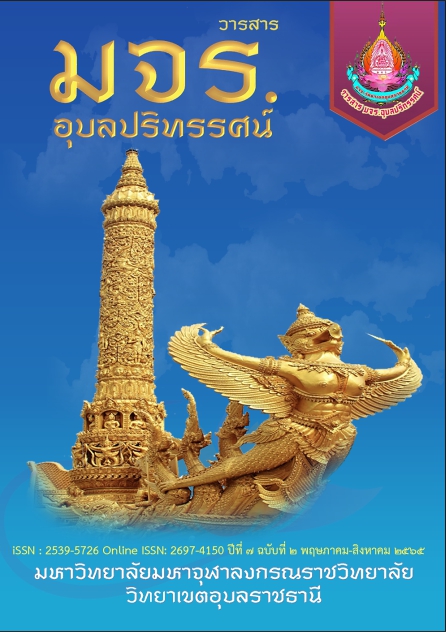TEACHING AND LEARNING BY BIM MODEL IN SUBJECT GROUP OF SOCIAL STUDY, RELIGION AND CULTURE (BUDDHIST SUBJECT)
Main Article Content
Abstract
Teaching and learning management, that can develop students in all aspects for learners to solve various problems and appropriately apply them in their livings, could be implemented through BIM (Buddhist Instruction Model) or teaching and learning in Buddha model. It is a natural learning management so that learners have the characteristics of being a good person with knowledge and ability through the process of self-problem solving with mindfulness, wisdom, rationality and commitment in investigating the real root causes of the problems. In addition, BIM is a teaching method similar to the Buddhist teaching method i.e. a teaching and learning management by applying important Buddhist principles to develop as a teaching model. In other words, BIM-based teaching and learning management is an instructional management that is linked to the principles of Dhamma. The application of Dhamma principles in teaching and learning aims at enabling learners to understand nature and live properly that the teachers manage an appropriate environment to encourage learners to practice moral behavior, have discipline, create concentration, develop a quality mind, and use their knowledge and wisdom to think, solve problems and create knowledge that is suitable for learners to develop themselves in all aspects.
Article Details
References
กระทรวงศึกษาธิการ. (2552). หลักสูตรแกนกลางการศึกษาขั้นพื้นฐานพุทธศักราช 2551. กรุงเทพฯ: โรงพิมพ์ชุมนุมสหกรณ์การเกษตรแห่งประเทศไทย.
กิตติชัย สุธาสิโนบล. (2559). การจัดการเรียนการสอนแบบพุทธะ เพื่อพัฒนาคุณธรรมจริยธรรมสำหรับนักเรียน BUDDHIST INSTRUCTION MODEL. กรุงเทพฯ: คอมเมอร์เชียล เวิลด์ มีเดีย.
ขวัญฟ้า รังสิยานนท์. (2552). การพัฒนารูปแบบการจัดกิจกรรมกระบวนการเรียนรู้แนวพุทธสำหรับเด็กปฐมวัย. บัณฑิตวิทยาลัย: มหาวิทยาลัยรามคำแหง.
จินตนา ธนวิบูลย์ชัย. (2559). หน่วยที่ 11 การคิด การคิดแก้ปัญหาและการตัดสินใจ. ในประมวลสาระชุดวิชาจิตวิทยาเพื่อการดำรงชีวิต.นนทบุรี:มหาวิทยาลัยสุโขทัยธรรมาธิราช.
พระธรรมปิฏก. (2546). พุทธวิธีในการสอน. พิมพ์ครั้งที่ 6. กรุงเทพฯ: พิมพ์สวย.
พระพรหมคุณาภรณ์ ป.อ. ปยุตฺโต. (2549). คู่มือมนุษย์. กรุงเทพฯ: วิชั่นบุ๊คส์.
พระไพศาล วิสาโล. (2544). พุทธศาสนาไทยในอนาคต แนวโน้มและทางออกจากวิกฤต. พิมพ์ครั้งที่ 2. กรุงเทพฯ: มูลนิสดศรี-สฤษดิ์วงศ์.
วรวิทย์ วศินสรากร. (2552). การศึกษาไทย. กรุงเทพฯ: พัฒนาคุณภาพวิชาการ มหาวิทยาลัยศรีนครินทรวิโรฒ.
วิจารณ์ พานิช. (2556). การสร้างการเรียนรู้สู่ศตวรรษที่ 21. กรุงเทพฯ: ส.เจริญการพิมพ์.
สำนักงานสถิติแห่งชาติ กระทรวงเทคโนโลยีสารสนเทศและการสื่อสาร. (2558). วิเคราะห์เด็กและเยาวชน. กรุงเทพฯ: บางกอกบล็อก.
สุมน อมรวิวัฒน์. (2542). การพัฒนาการเรียนรู้ตามแนวพุทธศาสตร์: ทักษะกระบวนการเผชิญสถานการณ์. นนทบุรี: มหาวิทยาลัยสุโขทัยธรรมาธิราช.
สุระ ดามาพงษ์. (2553). คู่มือครู แผนการจัดการเรียนรู้ กลุ่มสาระการเรียนรู้สังคมศึกษา ศาสนาและวัฒนธรรม พระพุทธศาสนา ป.5. กรุงเทพฯ: โรงพิมพ์วัฒนาพานิช.

